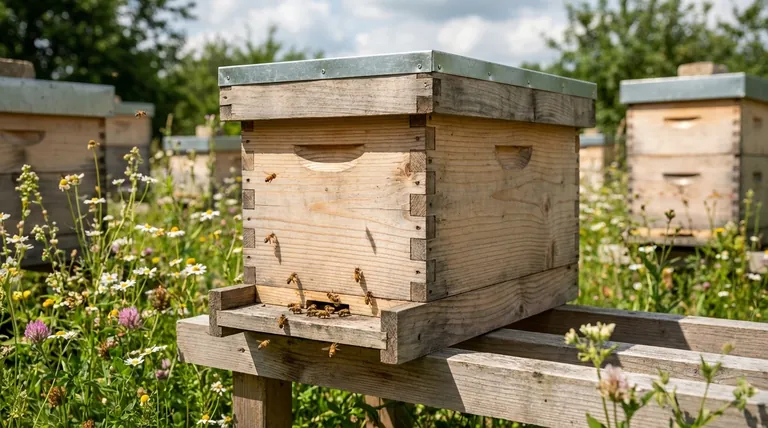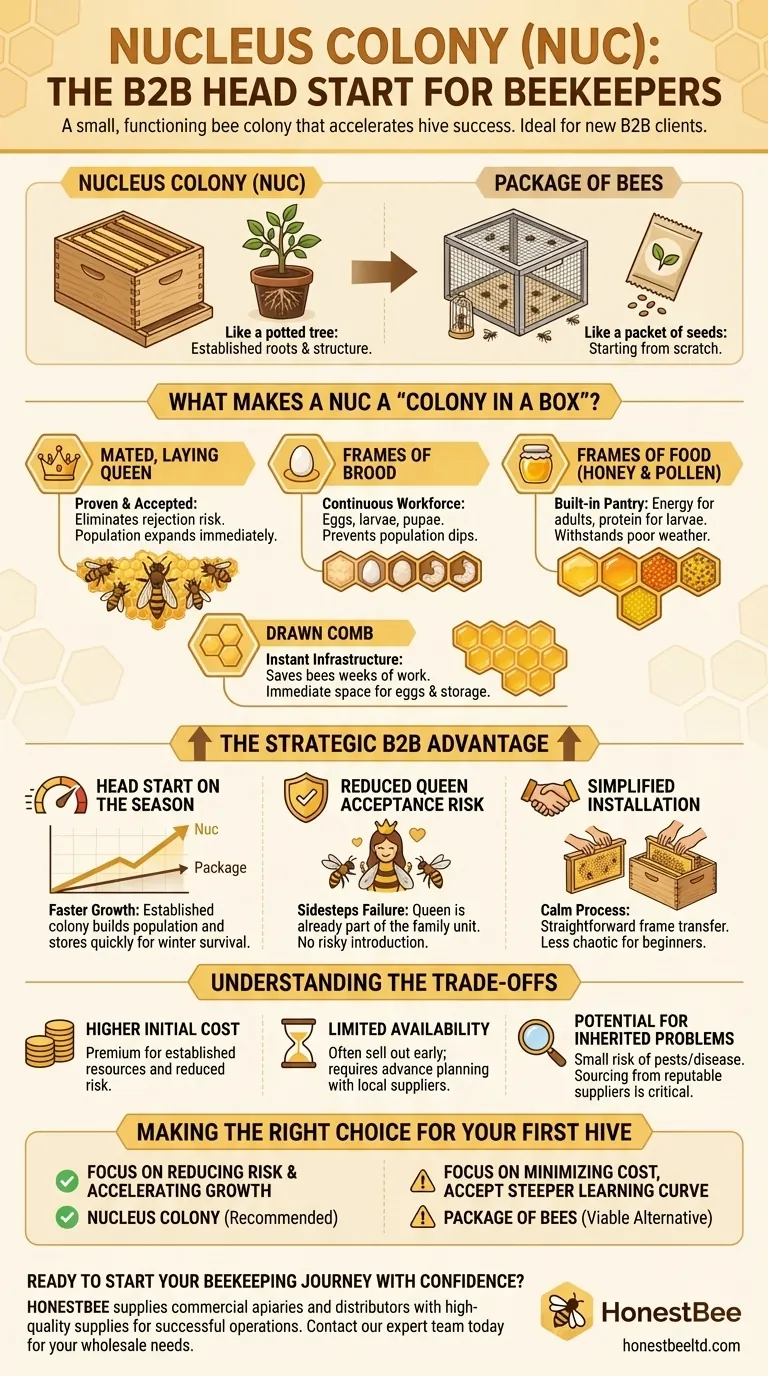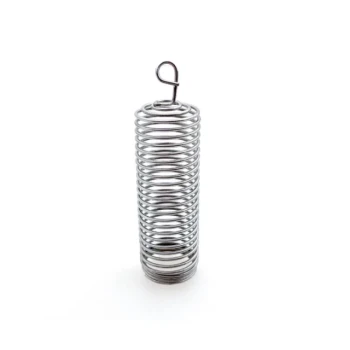A nucleus colony, or nuc, is a small, functioning bee colony sold on a set of frames, typically four or five. It contains a mated, laying queen, worker bees, and frames with brood (eggs and larvae), honey, and pollen, providing a complete and established starting point for a new beehive.
For a new beekeeper, choosing a nucleus colony is like buying a young, potted tree instead of a packet of seeds. It provides the essential structure and a significant head start, drastically increasing the odds of a successful first year.

What Makes a Nuc a "Colony in a Box"?
A nucleus colony is more than just a box of bees; it's a fully operational, miniature version of a mature hive. Each component serves a critical function that gives the colony immediate momentum.
The Mated, Laying Queen
The nuc includes a proven queen who is already accepted by the worker bees and is actively laying eggs. This eliminates the risk of queen rejection, a common and often fatal problem when installing a package of bees.
Her presence means the colony's population is already expanding from day one.
Frames of Brood
You receive frames containing brood in all stages: eggs, larvae, and capped pupae. This is the next generation of bees, set to emerge shortly after you install the nuc.
This staggered population ensures a continuous workforce for foraging, nursing, and hive defense, preventing a population dip that can stall a new colony.
Frames of Food (Honey & Pollen)
The nuc comes with its own pantry. Frames will contain stored pollen (protein for feeding larvae) and honey or nectar (carbohydrates for energy).
This built-in food supply ensures the colony can withstand poor weather and has the resources needed to fuel its rapid expansion without immediate stress.
Drawn Comb
Bees expend an enormous amount of energy to produce wax and build honeycomb. A nuc provides several frames of drawn comb, which is pre-built infrastructure.
The queen has immediate space to lay eggs, and workers have immediate space to store incoming nectar and pollen, saving the colony weeks of construction work.
The Strategic Advantage for a New Beekeeper
Starting with a nuc isn't just easier; it fundamentally changes the trajectory of your first season by mitigating common points of failure.
A Head Start on the Season
Because a nuc is already an established colony, it can grow much faster than a package of bees, which must build all its comb and raise its first round of brood from scratch.
This head start means the colony is more likely to build up sufficient population and honey stores to survive its first winter—the single greatest challenge for a new hive.
Reduced Queen Acceptance Risk
In a package, the queen is a stranger to the thousands of shaken bees and must be slowly introduced and accepted. If the workers reject and kill her, the colony is doomed without quick intervention.
A nuc completely sidesteps this high-stakes variable. The queen and workers are already a cohesive family unit.
Simplified Installation
Installing a nuc is a calm and straightforward process. You simply transfer the frames from the nuc box into your full-sized hive equipment in the same order.
This is far less chaotic and intimidating for a beginner than shaking thousands of loose, disoriented bees from a package into a new hive.
Understanding the Trade-offs
While highly recommended for beginners, a nucleus colony is not without its considerations. Objectivity requires acknowledging the downsides.
Higher Initial Cost
A nuc is almost always more expensive than a package of bees. You are paying a premium for the established brood, drawn comb, and reduced risk that a proven mini-colony provides.
Limited Availability
Nucs are typically produced by local beekeepers and are in high demand. They often sell out months in advance of the spring season, requiring you to plan ahead and place an order early.
Potential for Inherited Problems
Because you are buying established frames, there is a small risk they could come with pests like Varroa mites or traces of brood disease. This is why purchasing from a highly reputable, certified, and transparent local supplier is absolutely critical.
Making the Right Choice for Your First Hive
Your choice of how to start your first colony is one of the most significant decisions you will make as a beekeeper. It directly impacts your workload, stress level, and chance of success.
- If your primary focus is reducing risk and accelerating growth: A nucleus colony from a reputable local supplier is the undisputed best choice.
- If your primary focus is minimizing initial cost and you accept a steeper learning curve: A package of bees is a viable alternative, but you must be prepared for the added challenges of queen introduction and comb construction.
Ultimately, starting with a nucleus colony empowers you to focus on learning bee behavior and hive management, rather than struggling through a high-risk establishment phase.
Summary Table:
| Feature | Benefit for Beginner Beekeeper |
|---|---|
| Mated, Laying Queen | Eliminates queen rejection risk; colony expands immediately. |
| Frames of Brood | Continuous workforce; prevents population dips. |
| Frames of Honey & Pollen | Built-in food supply for energy and larval nutrition. |
| Drawn Comb | Saves bees weeks of energy; provides instant infrastructure. |
Ready to start your beekeeping journey with confidence?
A strong start is critical for a thriving hive. HONESTBEE supplies commercial apiaries and beekeeping equipment distributors with the high-quality supplies and equipment needed to support successful beekeeping operations, from the very first nuc to a full-scale apiary.
Contact our expert team today to discuss your wholesale needs and ensure your beekeeping venture is built on a solid foundation.
Visual Guide

Related Products
- 5 Frame Wooden Nuc Box for Beekeeping
- No Grafting Queen Rearing Kit: System for Royal Jelly Production and Queen Rearing
- Nicot Queen Rearing Kit for Beekeeping and Grafting in Nicot System
- Jenter Queen Rearing Kit Complete Set for Bee Breeding
- Langstroth Honey Bee Box Hive Boxes for Different Depths
People Also Ask
- What are the benefits of moving nuclei around the apiary? Master Strategic Hive Management
- What is a common feature of many 5-frame nuc boxes? The Integrated Feeder for Efficient Colony Growth
- How many frames does a typical wooden nuc box hold? A Guide to Choosing the Right Size
- What frames should be moved into the queenless hive when requeening with a nuc? Ensure a Successful Queen Introduction
- How should the nuc be installed in the apiary? Ensure Colony Success from Day One



















